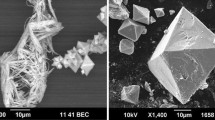Abstract
Nanocrystalline gallium- and indium-doped zinc oxide samples have been prepared through coprecipitation from aqueous solutions. Acid centers on the surface of the materials have been investigated using temperature-programmed desorption and IR spectroscopy. The results demonstrate that, with increasing dopant concentration, the density of OH groups on the surface of ZnO〈Ga〉 and ZnO〈In〉 increases and the contribution of cation centers to surface acidity decreases. The interaction of the material with oxygen has been studied using in situ electrical conductivity measurements. Doping of zinc oxide with gallium or indium has been shown to increase the percentage of molecular chemisorbed oxygen species on the surface of the material.
Similar content being viewed by others
References
Ozgur, U., Alivov, Ya.I., Liu, C., Teke, A., Reshchikov, M.A., Dogan, S., Avrutin, V., Cho, S.-J., and Morkoc, H., A comprehensive review of ZnO materials and devices, J. Appl. Phys., 2005, vol. 98, paper 041301.
Hagemark, K.I. and Toren, P.E., Determination of excess Zn in ZnO. The phase boundary Zn–Zn1 + x O, J. Electrochem. Soc., 1975, vol. 122, pp. 992–994.
Park, C.O. and Akbar, S.A., Ceramics for chemical sensing, J. Mater. Sci., 2003, vol. 38, pp. 4611–4637.
Ellmer, K., Transparent conductive zinc oxide and its derivatives, Handbook of Transparent Conductors, Ginley, D.S., et al., Eds., New York: Springer, 2010, pp. 193–263.
Shannon, R.D., Revised effective ionic radii and systematic studies of interatomic distances in halides and chalcogenides, Acta Crystallogr., Sect. A: Cryst. Phys., Diffr., Theor. Gen. Crystallogr., 1976, vol. 32, no. 5, pp. 751–767.
Davydov, A., Molecular Spectroscopy of Oxide Catalyst Surfaces, Chichester: Wiley, 2003.
Rao, T.P. and Kumar, M.C.S., Physical properties of Ga-doped ZnO thin films by spray pyrolysis, J. Alloys Compd., 2010, vol. 506, pp. 788–793.
Vorobyeva, N., Rumyantseva, M., Filatova, D., Konstantinova, E., Grishina, D., Abakumov, A., Turner, S., and Gaskov, A., Nanocrystalline ZnO(Ga): paramagnetic centers, surface acidity and gas sensor properties, Sens. Actuators, B, 2013, vol. 182, pp. 555–564.
Barsan, N. and Weimar, U., Conduction model of metal oxide gas sensors, Electroceramics, 2001, vol. 7, pp. 143–167.
Rumyantseva, M.N., Makeeva, E.A., Badalyan, S.M., Zhukova, A.A., and Gaskov, A.M., Nanocrystalline SnO2 and In2O3 as materials for gas sensors: the relationship between microstructure and oxygen chemisorption, Thin Solid Films, 2009, vol. 518, pp. 1283–1288.
Ozawa, K. and Edamoto, K., Photoelectron spectroscopy study of ammonia adsorption on ZnO(1010), Surf. Rev. Lett., 2002, vol. 9, pp. 717–722.
Boccuzzi, F., Morterra, C., Scala, R., and Zecchina, A., Infrared spectrum of microcrystalline zinc oxide. Electronic and vibrational contributions under different temperature and environmental conditions, J. Chem. Soc., Faraday Trans., 1981, vol. 77, pp. 2059–2066.
Keyes, B.M., Gedvilas, L.M., Li, X., and Coutts, T.J., Infrared spectroscopy of polycrystalline ZnO and ZnO:N thin films, J. Cryst. Growth, 2005, vol. 281, pp. 297–302.
Noei, H., Qiu, H., Wang, Y., Löffler, E., Wöll, C., and Muhler, M., The identification of hydroxyl groups on ZnO nanoparticles by infrared spectroscopy, Phys. Chem. Chem. Phys., 2008, vol. 10, pp. 7092–7097.
Krivetskii, V.V., Rumyantseva, M.N., and Gaskov, A.M., Chemical modification of nanocrystalline tin dioxide for selective gas sensors, Usp. Khim., 2013, vol. 82, no. 10, pp. 917–949.
Author information
Authors and Affiliations
Corresponding author
Additional information
Original Russian Text © N.A. Vorob’eva, A.V. Marikutsa, M.N. Rumyantseva, V.F. Kozlovskii, D.G. Filatova, A.M. Gaskov, 2016, published in Neorganicheskie Materialy, 2016, Vol. 52, No. 6, pp. 629–634.
Rights and permissions
About this article
Cite this article
Vorob’eva, N.A., Marikutsa, A.V., Rumyantseva, M.N. et al. Effect of Ga and in doping on acid centers and oxygen chemisorption on the surface of nanocrystalline ZnO. Inorg Mater 52, 578–583 (2016). https://doi.org/10.1134/S0020168516060182
Received:
Published:
Issue Date:
DOI: https://doi.org/10.1134/S0020168516060182




